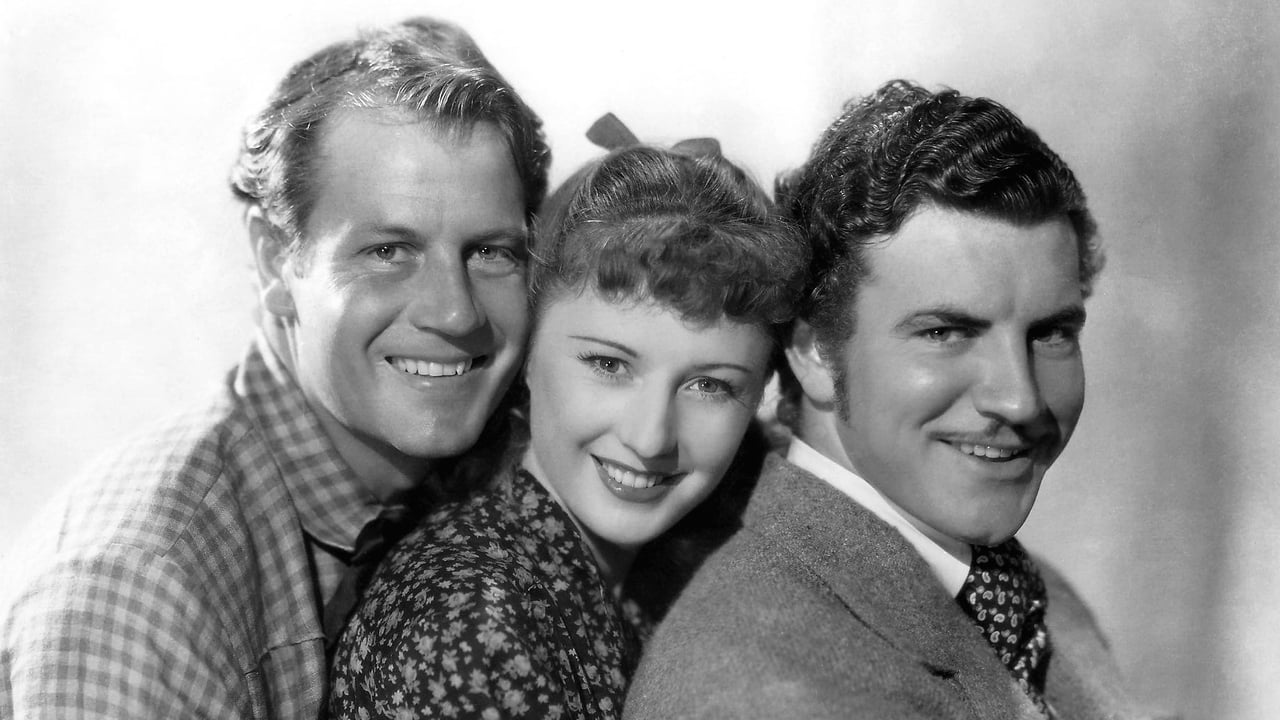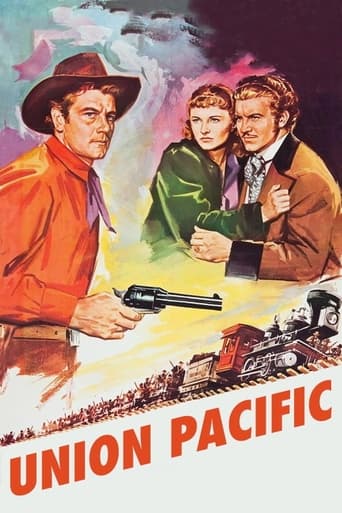

Good , But It Is Overrated By Some
... View MoreI like movies that are aware of what they are selling... without [any] greater aspirations than to make people laugh and that's it.
... View MoreA Brilliant Conflict
... View MoreWorth seeing just to witness how winsome it is.
... View More"Union Pacific" is a very good Western movie with a top Hollywood cast of the day. It has action, adventure and romance. It combines fiction with fact in telling the story of building the Union Pacific Railroad. Congress had authorized the Transcontinental Railroad in 1862 to connect the existing eastern U.S. rail network with the Pacific Coast. The project was 1,912 miles long and was built between 1863 and 1869 by three private railroad companies. At 1,085 miles, the UP was the longest and most difficult part of the "Overland Route," as it soon would become known. It ran from Omaha, Nebraska, to West of Ogden, Utah. It crossed the Great Plains and the Rocky Mountains. The Western Pacific Railroad built 132 miles of track from Oakland to Sacramento, and the Central Pacific Railroad built 690 miles of track from Sacramento to Promontory Point, Utah. It was in a race with the UP to get to Ogden. As the movie shows, the UP got there first and the two lines met at Promontory Summit, 66 miles northwest of Salt Lake City. A number of movies - especially Westerns, have scenes with trains or building rail lines in their plot. But, "Union Pacific" is the only film in which the plot centers on the building of a railroad. It shows men laying ties and rails, putting up and tearing down makeshift towns, and dealing with struggles. Those included terrain, weather, train followers, and plots to delay or undermine the rail lines. This movie is based on a 1936 novel, "Trouble Shooter," by Western fiction author Ernest Haycox. Movie fans will be familiar with his work from the 1939 blockbuster and Oscar winner, "Stagecoach." It was based on another 1936 Haycox novel, "Stage to Lordsburg." This film mixes fictional characters with real people. Chief among the latter is General Grenville Dodge, played by Francis McDonald. Dodge had earned an engineering degree in 1850 and settled in Council Bluffs, Iowa. He served as a Major General in the Union Army during the Civil War. Among his many achievements was his pioneering use of military intelligence. Pres. Abraham Lincoln asked Dodge to help build the Transcontinental Railroad. He resigned from the Army to be chief engineer for the Union Pacific. Dodge also served in congress and later helped build a number of other railroads. Other real people portrayed are Oakes Ames (played by Willard Robertson), Gen. Ulysses S. Grant (Joseph Crehan), Thomas Durant (John Marston, uncredited), and California Gov. Leland Stanford (Gus Glassmire). The rest of the cast are fictional. The film has some big name stars and top supporting actors of the day. These all give top performances. Barbara Stanwyck is very believable with her Irish accent as Mollie Monahan. Joel McCrea is Jeff Butler, Robert Preston is Dick Allen and Brian Donlevy is Sid Campeau. Anthony Quinn has a small part as Cordray, and a top supporting cast includes Akim Tamiroff as Fiesta, Lynne Overman as Leach Overmile, Henry Kolker as Asa Barrows, Regis Toomey as Paddy O'Rourke, Lon Chaney Jr. as Dollarhide, and Ward Bond as a track-layer. The film has a cast of hundreds with many more regular supporting actors in bit roles. Most of them are as gandy dancers - the men who worked on the crews that laid the rails. As the movie shows, the Union Pacific was built mostly by Irish immigrants. The Central Pacific railroad that met the UP in Utah was built mostly with Chinese labor. In other parts of the country, men of other ethnic groups formed the main work forces that built the railroads. The film doesn't show it, but a special crew from both railroads was chosen to complete the link up at Promontory Point. That team of Irish and Chinese gandy dancers took just 12 hours to lay the final 10 miles of track. Today, the Union Pacific is the largest railroad in the U.S. It operates 14 hump yards where trains are assembled for routing to all corners of the U.S. and Canada. The Bailey Yard at North Platte, Nebraska, is the world's largest hump yard. It has 200 tracks and marshals a daily average of 139 trains and 14,000 cars. Tourists can watch the operation from the Golden Spike Tower at the visitors center. The Union Pacific Museum is located in Council Bluffs, Iowa, across the Missouri River from Omaha. In 1936, the Union Pacific built the Sun Valley ski resort in Idaho. It sold Sun Valley in 1964.The site of the joining of the UP and CP railroads at Promontory Point, Utah, is now the Golden Spike National Historic Site. The park has a museum with actual size replicas of the 1865 trains that met there -- the UP No. 119 and Central Pacific No. 60, "Jupiter." The park re-enacts the Golden Spike ceremony weekly on Saturdays from spring to fall. The main operating railroad line long ago was relocated south of the Great Salt Lake. It cut the length of the route by 43 miles and took out some curves and hills. Although the driving of the Golden Spike was attributed to California Gov. Leland Stanford at the time, he and the next person both missed the spike as the movie shows. The character of Ames in the movie is fictional, but may be based on one or more real characters. Apparently, the real pounder of the Golden Spike will never be known. Maybe it was a gandy dancer. In "Union Pacific," Cecil B. DeMille gives us first-rate entertainment. It's a good Western, adventure and romantic film with a look at history that people young and old should enjoy. P.S. - I climbed poles and dug bootlegs for the UP one year after Army service before heading off to college.
... View MoreStill another great 1939 film is "Union Pacific." The film, which is rich in history, is about the coming of the railroad linking the east and west and those who would do anything to destroy the construction of this mighty link.Barbara Stanwyck puts on an authentic Irish accent as lassie Mollie Monahan, and she is Mollie to a tee. Her love interests include Joel McRea as the overseer to make sure that the railroad is constructed, and his friend, Robert Preston, who unfortunately takes to the wrong side on this one, when he joins forces with always bad Brian Donlevy, a stooge for a financier who will stop at nothing to prevent the completion of this project.The film has everything-history, lust, a great train wreck, Indian uprisings and greed as well as desire.
... View MoreIt has plenty of action, a love story, an exciting race between two railroads, skulduggery, good production values, marauding Indians, thoroughly stereotyped characters, and an absence of anything that might suggest unpredictability or ambiguity -- what's not to like? It's the post Civil War West and the Union Pacific Railroad is being built chiefly by Irish labor across the plains to Utah, where it will meet the Central Pacific being built from San Francisco. The race is on. A banker bets on the Central Pacific covering more ground and hires a gang of thugs including boss Brian Donlevy and Robert Preston to sabotage the Union Pacific's efforts. In turn, the Central Pacific's bankers hire a troubleshooter, McCrea. This pits McCrea and the Central Pacific against Donlevy, Preston, and a scrubby cabal of miscreants. In historical fact -- which is completely irrelevant to this movie -- the whole affair was mired in corruption. It led to the age of the Robber Barons. One of them held a monopoly on railroad ties and accumulated a sufficient fortune to establish the university which I was privileged to attend.McCrea is his usual all-American self. He wears his sixguns with their carved keratic handles in a cross draw. Preston, a mustachioed companero from the Union Army, is light-hearted and playfully criminal. Preston is deeply in love with Barbara Stanwyck, a railroad brat with an Irish accent. The true-blue McCrea falls in love with her too. Both men survive the savage Indian attack on a wrecked train, and only one of them lives through the final confrontation. Guess who survives and who dies with a few last words of remorse on his lips.Here's an example of the movie's values. McCrea has just been hired to straighten things out. He's aboard a train chugging West. He's wearing a neatly pressed cowboy shirt with a string tie. Also, though McCrea doesn't know it, some of his fellow passengers are members of Donlevy's gang. They wear SUITS. A Sioux Indian is happily racing his pony alongside the train, whooping and waving in a friendly way. One of the suits bets that the Indian can be picked off with one rifle shot. The suit wins. The Indian tumbles from his horse, dead. McCrea, seeing this, is inflamed. He dashes over and deals out punishment. The punishment consists of a fist fight that the suit loses. The suit falls from the train and is left behind, brushing off the dust and scowling. That's the punishment for murdering an Indian. And what's the logic behind the punishment? "That man didn't just kill an Indian -- he killed half a dozen white men working on the railroad." A similar story was told in John Ford's 1924 production, "The Iron Horse," but this is equally enjoyable. Ford's movie was a silent, and George Bancroft was full of muscles but not as likable as Joel McCrea. Stanwyck should stay away from roles calling for an Irish accent. But I liked this quite a lot. I don't want my thoughts provoked too often anyway. Sometimes, the simpler the better, even to the point of simple mindedness.
... View MoreUnion Pacific is directed by Cecil B. DeMille (aided by others due to illness) and based upon the novel Trouble Shooter, written by Ernest Haycox. It stars Barbara Stanwyck, Joel McCrea, Robert Preston, Brian Donlevy, Akim Tamiroff and Lynne Overman. Story is a fictionalised account of the building of the railroad across the American West, encompassing the trials, tribulations and rivalries that formed as history was being made."The legend of Union Pacific is the drama of a nation, young, tough, prodigal and invincible, conquering with an iron highroad the endless reaches of the West. For the West is America's Empire, and only yesterday Union Pacific was the West".A big production that went down a storm at the box office on release, Union Pacific, in spite of its overt patriotic bluster, is an entertaining and important part of the Western movie story. Alongside John Ford's Stagecoach, which was released a couple of months previously, DeMille's movie helped take the Western to a new, more adult, level. It wouldn't be until the 50's that the Western truly found its mojo, but the influence of both Stagecoach and Union Pacific was firmly felt thru each passing decade. Film manages to be literate whilst puncturing the plot with doses of action, while the story is underpinned by a love triangle between McCrea, Stanwyck and Preston. The former as the stoic troubleshooter brought in to keep order, the latter as the charming villain with a heart. Cast all work well with the material to hand, and if one is not bothered by the historical tampering involved in the story? Then it's an easy film to recommend to Western movie seekers. 7/10
... View More